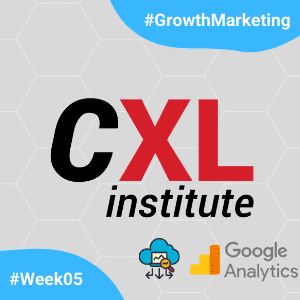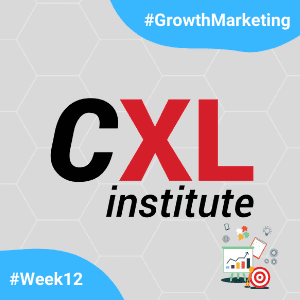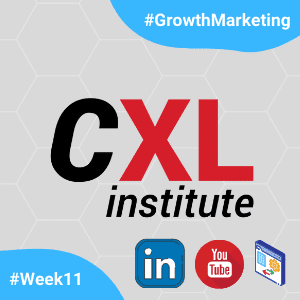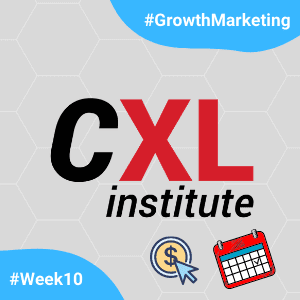Another step completed! With the course Intermediate Google Analytics, I finish another week of the Growth Marketing Scholarship Program learning path from CXL Institute.
The program consists of 12 weeks of learning in which I study the Growth Marketing Minidegree. At the end of each week, I write a little about what I have learned. So far, I have released the following texts:
- Week 01: organization of the course and the relevance of the topic.
- Week 02: importance of carrying out growth experiments.
- Week 03: A / B testing and statistical grounds for more assertive results.
- Week 04: Google Analytics for beginners. Main features, reports and analysis.
For the fifth week of learning, I continue my studies on Google Analytics (GA), advancing to the next level with the intermediate course version also taught by Chris Mercer. The course is slightly shorter than the version for beginners (6 hours vs. 9 hours), but it is certainly more demanding. The course is structured as follows:
- Introduction
- Clean Data
- Finding Answers
- Tips & Tricks
- Conclusion
(CXL course: Intermediate Google Analytics)
As in the first course for beginners, each section is divided into multiple lessons and each lesson has its objectives and conclusions, facilitating learning. Below, I organized a small compilation of what was covered in each of the sections, making it possible to have an overview of what is taught in the course. However, for those who wish to improve their knowledge of the GA tool and apply the best available techniques, the ideal is to put the knowledge into practice, following the instructions of the teacher.
Introduction
In the first part of the course, Mercer talks about the importance of being prepared for this new stage in learning Google Analytics, making it clear that some elementary topics, such as multiple Views, Filters, Goals and basic navigation between reports, will not be treated in the course and will be considered as prior knowledge. Following the instructions of the previous course, the version for beginners, advancing to this new stage should be possible.
Then, the subjects that will be taught in this specific course are presented, the first one is the concept of “Dirty Data” and “Clean Data”. An entire section is dedicated to transforming and cleaning data so that we have a good story, which is crucial for efficient analysis.
“Clean Data Makes the Story Easier to Read”, Chris Mercer
The next section is about finding answers. The instructor rescues the concept of QIA (Question Information Action), already presented in the beginner version of the Google Analytics course. We need a Question to be answered, Information to answer that question and an Action to be taken based on the answers found.
Finally, there is a Tips & Tricks section, in which different items and techniques are shown. We will not necessarily always use those, but they can increase the efficiency of Analytics.
Clean Data
A fundamental concept that guides the section is the story that Google Analytics has to tell. To put this story together, however, we need relevant data, data that helps us understand what is happening with a particular problem or situation. We need to transform information and adapt the data we have.
“Google Analytics has a story to tell. Good data has a story to tell. Great data tells you the story ”. Chris Mercer
And how to transform the data?
Various techniques presented in this section will help. The instructor starts by talking about Filtering Out SPAM, showing what SPAM looks like in Google Analytics and what are the necessary steps to remove it.
Next, we look at the definition of Internal Hits, our internal traffic, and how to handle and remove it so as not to compromise analysis.
Finally, we look at Cross-Domain Tracking, knowing the concept, diagnosing problems and the basic configuration of cross domain tracking. This concept is important, as it directly affects assignments and so much other information in the reports, which emphasizes the relevance of having clean and treated data. Failure to carry out this cleaning step can lead us to find the wrong answers, which result in business decisions that generate that drain time and other resources.
Finding Answers
With the QIA (Question Information Action) method, we have Questions to be answered, we know the Information needed to answer these questions and, finally, Actions will be generated on top of these answers. But how do you find those answers within Google Analytics? This is the theme of this new section.
Initially, Mercer talks about Funnel Tracking, showing how to track different steps and different actions using different styles of funnels in Analytics, as well as how to create tables and how to generate Funnel Visualization and Goal Flow reports.
Next we go on to Segments, dealing with how to use the built-in options and how to create new ones, in order to deal with a specific situation. We ended by talking about Custom Reports, where Mercer shows us how we can find answers. We use tailor-made reports to answer a specific question and that do not have clear answers in the reports available.
Tips & Tricks
The last section of the course is full of small solutions that make the job easier. Depending on the user’s analysis routine, some of the tips can greatly increase productivity and efficiency.
The first topic covered was Dashboards, in which the instructor takes a short tour of Google Analytics Dashboards and how to use the Gallery.
Then, Mercer talks about Saved Reports & Alerts, where he shows how it is possible to increase efficiency with saved reports that have already been customized, edited and that may include other dimensions, filters and segments. To find specific answers, not having to recreate some views can be instrumental in answering some questions. It is even possible to create alerts customizable for these reports, creating a quality of proactivity on the part of them, warning when specific events have happened, such as when some predetermined revenue falls below a certain level.
Next, we talk about Channels: how to use them, understand them, and create them. Within this part, we see some interesting possibilities within the GA, as assisted conversions and last-click conversions, part of the Multi-Channel Funnel Reports.This lesson helps to understand how the channels and traffic sources interact with each other and how this interaction generates different results in the conversion metrics being analyzed, that is, how the channels fit within the Traffic Story.
In continuity, we see about Attribution, starting with its concept. We see the differences in the treatment of assignments between Source-Medium Report and Multi-Channel Reports. Also, in this lesson, we see how to use different attribution models in order to understand a little better how the different traffic sources work.
The next topic must have been one of my favorites in the course. Not that it is the most important, but the possibilities that arise with this new option: Export Data to Google Sheets. Perhaps for most users this is just another functionality, but for someone who has always used spreadsheets to perform various business analyzes, this part is especially exciting. The instructor shows how to use the Google API (Application Programming Interface) to transfer data programmatically from GA to Sheets and how to automate reports, further increasing customization and efficiency. For data presentation, it is still desirable, of course, to look for solutions in tools made for this, such as Data Studio. However, for punctual and quick analyzes, in which we want an easier interaction with the data, having the information in Google Sheets is quite advantageous.
We ended with the topic of Measurement Protocol, the dream of behavior analyzers. Through this functionality, we can track any type of behavior, even if it is not happening on our website, such as some types of offline behavior. Still incipient and maybe a little scary, but the possibilities are huge.
Conclusion
In conclusion, Chris Mercer shows another trick for our range of possibilities: Custom Metrics. Basically, calculable fields to insert in our follow-ups. A feature of many possibilities!
To conclude, as in the previous week, Chris mentions the importance of consuming content about GA, to keep us updated. Among the recommended resources are the Online Metrics, Analytics Ninja and the Google community.
To continue the journey, Mercer recommends the courses at the CXL Institute on Google Tag Manager and Data Studio, to improve data collection and presentation.
Next week…
For the next step, I’ll finally get to the long-awaited Google Tag Manager. After so many references in the last two weeks, it is very difficult not to look forward to getting to know the tool better. See you in the week 06 text of the Growth Marketing Minidegree.
Thank you for reading!




